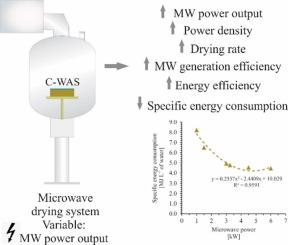Science of the Total Environment ( IF 9.8 ) Pub Date : 2020-06-27 , DOI: 10.1016/j.scitotenv.2020.140541 Eva Kocbek 1 , Hector A Garcia 2 , Christine M Hooijmans 2 , Ivan Mijatović 3 , Branko Lah 4 , Damir Brdjanovic 5

|
Sewage sludge management and treatment can represent up to approximately 30% of the overall operational costs of a wastewater treatment plant. Microwave (MW) drying has been recognized as a feasible technology for sludge treatment. However, MW drying systems exhibit high energy expenditures due to: (i) unnecessary heating of the cavity and other components of the system, (ii) ineffective extraction of the condensate from the irradiation cavity, and (iii) an inefficient use of the microwave energy, among others issues. This study investigated the performance of a novel pilot-scale MW system for sludge drying, specifically designed addressing the shortcomings previously described. The performance of the system was assessed drying municipal centrifuged wasted activated sludge at MW output powers from 1 to 6 kW and evaluating the system's drying rates and exposure times, specific energy outputs, MW generation efficiencies, overall energy efficiencies, and specific energy consumption. The results indicated that MW drying significantly extends the duration of the constant rate drying period associated with the evaporation of the unbound sludge water, a phase associated with low energy input requirement for evaporating water. Moreover, the higher the MW output power, the higher the sludge power absorption density, and the MW generation efficiency. MW generation efficiencies of up to 70% were reported. The higher the power absorption density, the lower the chances for energy losses in the form of reflected power and/or energy dissipated into the MW system. Specific energy consumptions as low as 2.6 MJ L−1 (0.74 kWh L−1) could be achieved, well in the range of conventional thermal dryers. The results obtained in this research provide sufficient evidence to conclude that the modifications introduced to the novel pilot-scale MW system mitigated the shortcomings of existing MW systems, and that the technology has great potential to effectively and efficiently drying municipal sewage sludge.
中文翻译:

微波处理市政污水污泥:评估中试规模微波干燥系统的干燥性能和能量需求。
污水污泥的管理和处理最多可占废水处理厂总运营成本的30%。微波干燥已被认为是污泥处理的可行技术。但是,由于以下原因,MW干燥系统显示出高能量消耗:(i)不必要地加热腔体和系统的其他组件;(ii)从辐照腔体中冷凝物的提取效率不高;以及(iii)微波使用效率低下能源等问题。这项研究调查了用于污泥干燥的新型中试规模兆瓦系统的性能,该系统经过专门设计解决了上述缺点。评估系统的性能,以1到6 kW的MW输出功率干燥市政离心浪费的活性污泥,并评估系统的性能。干燥速率和暴露时间,比能量输出,兆瓦级发电效率,总体能效和比能耗。结果表明,MW干燥显着延长了与未结合污泥水的蒸发相关的恒速干燥期的持续时间,该阶段与蒸发水的低能量输入要求相关。此外,MW输出功率越高,污泥功率吸收密度和MW产生效率越高。据报道,兆瓦级发电效率高达70%。功率吸收密度越高,反射功率和/或消散到MW系统中的能量形式的能量损失的机会就越小。单位能耗低至2.6 MJ L 整体能源效率和单位能耗。结果表明,MW干燥显着延长了与未结合污泥水的蒸发相关的恒速干燥期的持续时间,该阶段与蒸发水的低能量输入要求相关。此外,MW输出功率越高,污泥功率吸收密度和MW产生效率越高。据报道,兆瓦级发电效率高达70%。功率吸收密度越高,反射功率和/或消散到MW系统中的能量形式的能量损失的机会就越小。单位能耗低至2.6 MJ L 整体能源效率和单位能耗。结果表明,MW干燥显着延长了与未结合污泥水的蒸发相关的恒速干燥期的持续时间,该阶段与蒸发水的低能量输入要求相关。此外,MW输出功率越高,污泥功率吸收密度和MW产生效率越高。据报道,兆瓦级发电效率高达70%。功率吸收密度越高,反射功率和/或消散到MW系统中的能量形式的能量损失的机会就越小。单位能耗低至2.6 MJ L 结果表明,MW干燥显着延长了与未结合污泥水的蒸发相关的恒速干燥期的持续时间,该阶段与蒸发水的低能量输入要求相关。此外,MW输出功率越高,污泥功率吸收密度和MW产生效率越高。据报道,兆瓦级发电效率高达70%。功率吸收密度越高,反射功率和/或消散到MW系统中的能量形式的能量损失的机会就越小。单位能耗低至2.6 MJ L 结果表明,MW干燥显着延长了与未结合污泥水的蒸发相关的恒速干燥期的持续时间,该阶段与蒸发水的低能量输入要求相关。此外,MW输出功率越高,污泥功率吸收密度和MW产生效率越高。据报道,兆瓦级发电效率高达70%。功率吸收密度越高,反射功率和/或消散到MW系统中的能量形式的能量损失的机会就越小。单位能耗低至2.6 MJ L 以及兆瓦发电效率。据报道,兆瓦级发电效率高达70%。功率吸收密度越高,反射功率和/或消散到MW系统中的能量形式的能量损失的机会就越小。单位能耗低至2.6 MJ L 以及兆瓦发电效率。据报道,兆瓦级发电效率高达70%。功率吸收密度越高,反射功率和/或消散到MW系统中的能量形式的能量损失的机会就越小。单位能耗低至2.6 MJ L-1(0.74 kWh L -1)可以达到,这在常规热干燥机的范围内也是如此。这项研究中获得的结果提供了足够的证据,可以得出结论,对新型中试规模的MW系统进行的修改可以减轻现有MW系统的缺点,并且该技术具有有效和高效地干燥市政污水污泥的巨大潜力。



























 京公网安备 11010802027423号
京公网安备 11010802027423号